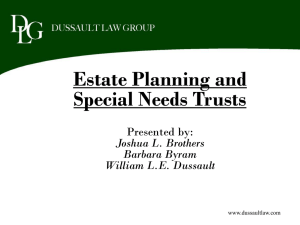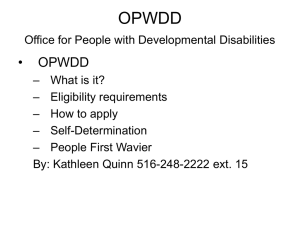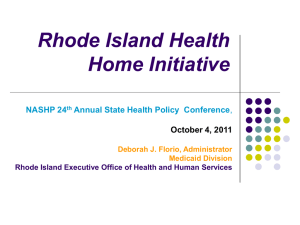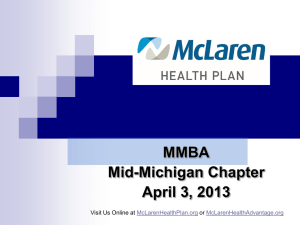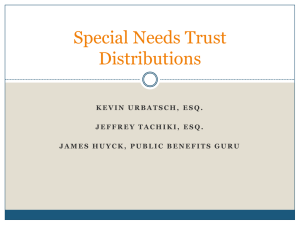PowerPoint - American Bar Association
advertisement
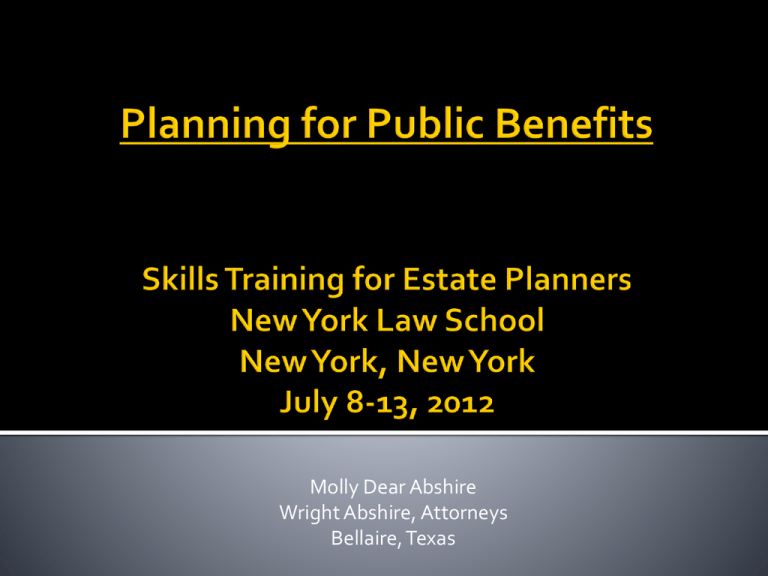
Molly Dear Abshire Wright Abshire, Attorneys Bellaire, Texas 20% of U.S. population is disabled at any given time. 10% of U.S. population is severely disabled and relies on benefit programs to provide for basic needs. Need for planning for public benefits is growing. Evaluates funding options for financing LTC Assists in qualification for public benefits Counsels regarding available programs Preserves existing public benefits Advises regarding estate planning documents and prepares same If capacity: Financial Power of Attorney Medical Directives Will and/or Trust If no capacity: Guardianship/Conservatorship Private pay Long-term care insurance Public benefits Medicare Medicaid VA Benefits Most people feel they will never need LTC When the need arises many cannot qualify for LTC insurance & premiums may be costprohibitive Many mistakenly believe that Medicare will cover LTC needs Long-Term Care Partnership Programs Not counted as income to the Medicaid recipient Benefits paid = assets can exclude Rising costs of care for disabled individuals Unavoidable Impoverishment Protection of the “Community Spouse” Private insurance exhausted Uninsurability Many personal needs left uncovered Clothing Dental care Transporation Trust planning can help close the gap Identify the client Avoiding fraud Diligent representation Malpractice for failing to preserve public benefits Client capacity and gifting Medicaid planning by non-attorneys Enacted March 23, 2010, fully implemented by Fall of 2014 Expansion of Medicaid benefits to qualified lower income retirees, effective in 2014, states may opt out. Federal High Risk Insurance Program Monthly cash assistance program For qualified individuals who are disabled before age 65 Worked appropriate number of quarters Must meet disability criteria Non-means tested benefit Federal Health Insurance Program 80/20 plan For eligible individuals 65+ and SSDI beneficiaries after 24 months Lifetime limits No LTC Non-means tested benefit Part A = in-patient services, home health, hospice and limited SNF Part B = doctor charges Part C = Medicare Advantage HMO Part D = voluntary drug plan Medicare has deductibles, co-pays and premiums Without Medigap, not 100% insured Choice of provider, but government regulated Open enrollment period For adult children with disabilities Provides 55% of base pay divided by eligible children TRICARE health coverage Non-means tested benefit Two Types: Service Connected Disability Compensation – injury, illness or aggravation of a pre-existing condition during active duty, non-means tested benefit Non-Service-Connected Disability Pension – low income disability payments, meanstested benefit Disability contracted during active duty (no wartime requirements) Veteran must not have been discharged dishonorably Injury must not be the result of misconduct Once disability is determined, a rating must be assigned Disability does not have to be service connected Don’t have to be retired military No requirement for combat Must meet income and net worth requirements Federal cash assistance program $698/month individual $1,048/month couple Provides minimum level of income for individuals with disabilities Means-tested benefit To be eligible person must be: Age 65 or older or blind or disabled, U.S. Citizen or qualified alien, and Not a resident of public institute. Income limitation Resource limitation <$2k for single individual in countable resources Excluded resources = home, car, prepaid funeral and household goods ISM = food & shelter Lesser of $ for $ reduction or 1/3 reduction of SSI Example: 1/3 reduction = [$698 x 1/3 = $292.67 + $20 disregarded income = $252.67] Joint federal and state funded program for medical services Means-tested benefit States administer Medicaid 3 different ways: 209b states SSI states 1634 states Example: Connecticut Use at least one eligibility criteria more restrictive than SSI program Example: Alaska If eligible for $1 of SSI, then eligible for Medicaid States determine eligibility Example: New York & Texas Use SSI eligibility, if eligible for $1 of SSI, then eligible for Medicaid SSA determines eligibility Hospital – in-patient & out-patient Physician services Physical therapy RX SNF Home and community Community supported living arrangements Personal care services Case management services Emergency care For low-income Medicare beneficiaries Vary according to income, Medicaid states and institutional status May pay deductibles, premiums and co-pays of Medicare Nursing Home Medicaid Waiver Programs Community Based Services Personal Care Services Categorical Requirements US Citizen/lawful alien 65 years of age or older, blind or disabled Medical necessity Medicaid facility, Medicaid bed Income Test Resource Test Cannot give assets away and qualify for means-tested public benefits 5 year look back period for all states Penalty rules vary by state Disclaimer not okay If there were no restrictions, many individuals would become eligible for Medicaid by giving their assets away The federal statute requires states to penalize transfers for less than fair market value In Texas, the transfer penalty affects payments for institutional facility services and eligibility for home and community based waiver programs Pursuant to OBRA ‘93 States required to recoup funds expended on Medicaid recipients at death MERP often affects homestead Federal housing subsidy Means-tested governmental benefit SNT not considered an asset for eligibility purposes Meet a needs based test determining inadequate income for adequate care Suffer from a permanent and total disability (100%) rating Veteran must not have been discharged dishonorably Must not be the result of misconduct Served at least ninety consecutive days, with at least one day during wartime Veterans with low incomes who are over age 65 are considered disabled Unreimbursed medical expenses may reduce countable income A surviving spouse is entitled to a lower pension, VA calls a “death benefit” The Veteran must have met the previous requirements The surviving spouse has not remarried And, meets the requirements for the level of compensation The estate of the Veteran must be insufficient to support the Veteran The net worth is the fair market value of all real and personal property Except for the homestead and value of personal items within the homestead Case by Case analysis No set amount or limit Based on actuarial life expectancy and shortfall $80,000 fallacy Many elderly Vets and spouses may qualify Allows elderly Vets to afford care at home or assisted living Could be used to pay for care during Medicaid Penalty Period Monthly cash assistance Means-tested benefit Beware of penalty period Aid and Attendance – for Veterans who are unable to perform activities of daily living without assistance Housebound Allowances – for Veterans who are permanently housebound and who meet the requirements for non-service connected disability pension Largest healthcare network in the country Service requirements Financial eligibility requirements Enrollment – 10-10EZ Priority/ Status Groups Preventative Care Services Ambulatory (out-patient) Diagnostic and Treatment Hospital (in-patient) Diagnostic and Treatment Medication and Supplies Federal & State Veterans’ Nursing Homes Most common tool to protect resources May be Self-settled Third-party settled They supplement (but do not supplant) public benefits. Individuals who are disabled and need public benefits. Family members of a disabled person who needs to maintain public benefits. SUPPLANTING Food Shelter Medical items or services paid by Medicaid SUPPLEMENTING Medical needs not covered by Medicaid Social needs Recreational needs Educational expenses 2 types: Special Needs Trust [(d)(4)(A)] Pooled Special Needs Trust [(d)(4)(C)] 65 y.o. beneficiary’s own money Corporate trustee Payback provision Settlor = parent, grandparent, guardian or court Irrevocable Beneficiary’s own money Shared corporate trustee/ administered by non-profit Payback provision Irrevocable Testamentary or Inter-Vivos Funded with third party funds Not a resource, unless client can revoke the trust or direct use of its assets for his own support and maintenance Distributions to/for client can be countable income (unless for medical/social purposes) Self-Settled Trusts v. Third-Party Trusts Self-Settled Trusts: funded with the beneficiary’s own money Third-Party Trusts: funded with other people’s money Always ask yourself: where is the money coming from to fund this trust; not originally, but just before funding Elderly clients with capacity and I Love You Wills Leave estate to a SNT for benefit of surviving spouse Partition and transfer Client is parent/grandparent of disabled child Inter vivos or testamentary third party SNT Crummey provisions if taxable estate Disabled spouse is divorcing Consider funding SNT Disabled child’s parents divorcing Review effect of child support Consider funding SNT Elderly client with disabled child needs Medicaid eligibility Consider funding sole-benefit trust with SNT provisions for disabled child Immediate eligibility for client, continued eligibility for disabled child Client is receiving personal injury recovery Self-settled SNT or pooled trust Mandatory distribution language Corporate trustee Client is receiving inheritance Self-settled SNT or pooled trust Mandatory distribution language Corporate fee except in rare situation If trust is cost prohibitive, consider alternative action Spend down excess resources Purchase exempt resources SSI POMS standards plus some states impose additional requirements States have authority to monitor administration of and distributions from SNTs Trustee choice No contributions after age 65 Distribution standards Meet POMS requirements. Some states have non-profits who have formed pooled trusts. Example: Texas has one pooled trust: ARC of Texas SNT. New York has many pooled trusts. Irrevocable No support language Distribution provisions Termination clause No payback provision Corpus not a countable asset, unless client – Can revoke the trust; or Direct use of trust assets for his/her own support & maintenance Distributions to/or client are countable income (if such income is ordinarily counted) Other distributions do not affect client’s eligibility Distributions restricted to goods/services that do not count as income (no cash, food, or shelter) Any distribution is allowed that will not actually disqualify client for benefits. If client not on benefits, distribution for cash, food and shelter okay. Trustee may make distributions that result in in-kind support & maintenance (“ISM”), which reduces SSI payments, but does not eliminate benefits. Distributions for room and board, resulting ISM up to PMV ($252.67) okay. Distributions are totally at trustee’s discretion Trustee may make distributions in any amount & for any purpose In some states (not Texas) it automatically disqualifies client for Medicaid Texas Medicaid evaluates each distribution Notification to SSA Notification to state agency Distribution advice $ for $ reduction ISM ▪ Food ▪ Mortgage payments ▪ Rent ▪ Real property taxes ▪ Utilities Attendant Care Medical supplies and equipment Dental Electronic equipment Legal and accounting fees Entertainment, recreation, short vacation Non-food grocery items Telephone and cable expenses Clothing Self-settled SNTs funded with inheritances, excess funds and proceeds from PI claims Resolve Medicare claims, Medicaid liens Consider annuity structure tie-in to SNT Public benefits planning is a growing area of law SNTs are an important estate-planning tool Drafting SNTs is not a “one-size-fits-all” process Conform to federal and state law Inquire regarding beneficiary’s need for public benefits in every estate planning consultation



